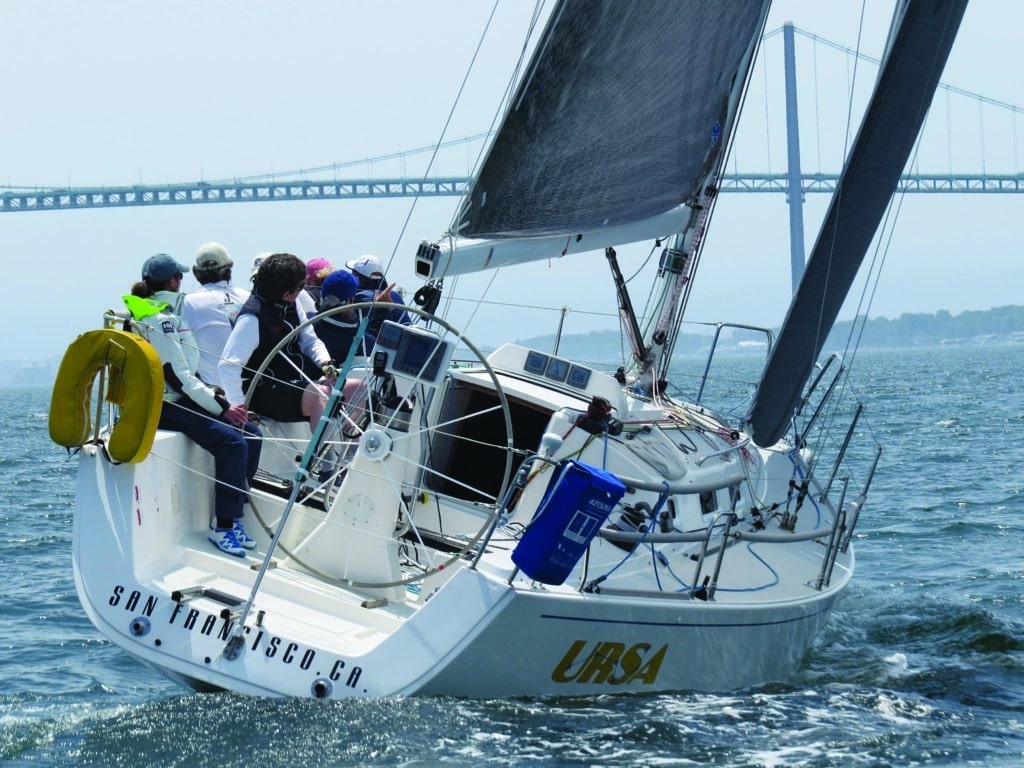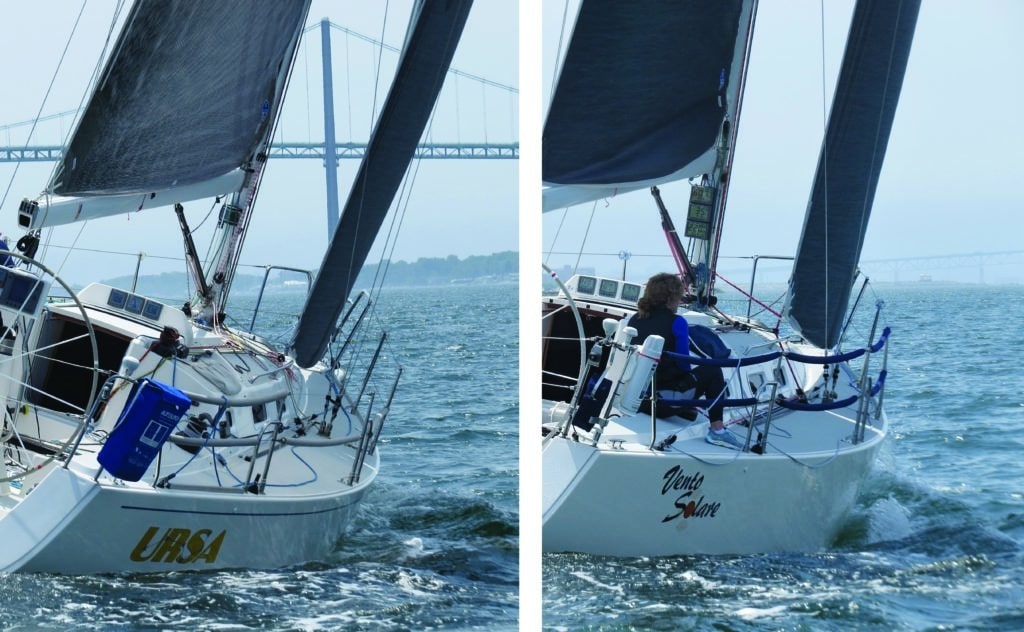
It’s the final race of the 1999 Farr 40 Worlds in San Francisco, and the breeze has built to 20 knots. I’m trimming the jib on Samba Pa Ti. Our experience tells us we don’t need any jib inhauler in anything above 15 knots, so I ease it all the way off. Our speed is excellent, and we overcome a large point deficit to win the championship by a point.
Fast-forward 17 years to the first day of racing at the 2016 Farr 40 Worlds in Sydney. This time I’m trimming the jib on Plenty. Again it’s blowing 20 knots, but this time the jib is almost fully inhauled. We come off the starting line, peel off three boats that start above us, finish the day in the lead, and go on to win the championship — with the same boat and wind velocity, but a major change in how we trim our jib.
What led us to change our approach to jib trim? While I believe this has mostly been a change in technique, sailcloth development has also allowed for ever-narrowing sheeting angles. Jibs are now flatter in the back of the sail and produce straighter exit angles. With better materials, they’re also less likely to stretch into rounder profiles as the wind increases.
Inhauling is not limited to the Farr 40 class. Most grand-prix one-design classes have narrowed jib sheeting angles as well. Each time designers believe they’ve reached the limit, the next design comes with an even narrower option. In fact, the jib sheeting angle on a new TP52 is so narrow that it’s difficult for a crewmember to fit between the mast and jib leech when it’s sheeted on hard.
Although it’s a simplification, one saying I use is “The jib is your height; the main is your speed.” To maintain height, we leave the jib inboard as long as possible. Before we even think about changing it, we do what we can to reduce front load on the jib. We’ll go with more leech twist, a flatter foot (car aft), a flatter overall sail shape with more headstay tension, more jib halyard or jib cunningham, or rig tune. Only then will we move the lead outboard.
Jib sheeting systems on almost every sailboat fall into one of two categories: athwartship tracks or fore-aft tracks. In athwartship systems, such as those found on TP52s or Maxi 72s , the jib sheeting angle is determined by moving the sheeting point inboard or outboard. Here, moving the sheeting position fore and aft is controlled by a purchase system. The inboard limit of these tracks has progressively moved inboard year after year.
In fore-and-aft systems, such as what one would find on a Swan 45 or Farr 40 , the jib sheeting position is determined by moving the turning point forward or aft, and the angle is changed with an inhauler system. This method of adjusting the jib sheeting angle is more complicated than the method for athwartship tracks. Whichever system you use to deflect the sheet inboard, pay close attention to the effect it has on jib-foot depth. Different systems will produce different geometry. When you pull the jib inboard, does the foot get flatter? If so, the fore-and-aft position will need to go forward to compensate. This is the case on the Farr 40. However, the opposite applies on the Farr 30.
Since most athwartship tracks are straight, you may also see subtle differences in foot depth that result when the jib moves inboard. Another factor to remember is that the position of the sheet’s turning point does not determine the true sheeting angle; it’s the location of the sail that’s most important. In other words, with the sheeting position of a sail set at 7 degrees, the effective sheeting angle of a sail with a very low clew might be 7.1 degrees, which is caused by wind pressure pushing the sail outboard. A sail with a very high clew, however, might actually sit at 8 degrees, as the forces are able to push it farther outboard. To achieve a narrow sheeting angle for a jib with a higher clew, you will need to use more inhauler or move the athwartship position farther inboard.
The focus of this article is sheeting your jib more narrowly, but the jib can never be trimmed in isolation, as it has a critical effect on the mainsail. The best upwind performance happens when the jib and mainsail are in balance. Always consider what trimming one sail does to the other. A boat with a narrowly sheeted jib but a mainsail with the traveler down may be out of balance, possibly even washing out the main with backwash from the jib. Likewise, a boat with a widely sheeted jib but a mainsail sheeted very hard, with the traveler to weather, may create an imbalance.
There are, however, limitations to inhauling. If your jib is too round in the back, there may be too much drag to make the most out of it. Your inhauler system may also create friction during tacks, as you’re leading the jibsheet through the inhauler and the jib-car block or ring.
Boats that sail with less leeway don’t sheet their jib as narrowly, because the jib’s angle of attack is influenced by how much or how little the boat is slipping sideways through the water. The more the jib is sliding to leeward in space, the more narrowly it should be sheeted to correct the effective angle of attack.

Real-World Use
Figure out a system that works for your boat and practice using it, or experiment with using more of it if you’ve been using inhaulers already. Mark all your control lines so you can repeat fast settings.
Now it’s time to race. You can get the most out of narrower jib sheeting off an upwind starting line. We have a mode on Plenty and the Maxi 72 Bella Mente called “flaps-down,” which we stole from the aviation industry. Planes take off with flaps down to create maximum lift. We go into the same mode to generate our own maximum lift. Our trim from behind looks ridiculous, especially compared with former standards of what was thought reasonable, with the jib sheeted very narrowly and the mainsail traveler high to weather.
The result is that we regularly point higher with the same speed as teams that start above us. The best case for them is that they can tack away when we get to them. The worst case is, as often happens in the first minute or two off the start, that the boats are still on starboard close together, and there is nowhere to go. Then we put the hurt on boat after boat and make gains at the most important time of the race. This setup is not exclusively for use off the starting line. Remember, the jib is your height; the main is your speed.
Once in the open course, don’t blame the sheeting angle if you’re slow. Twist the main first. Press on the jib. Watch the numbers increase. If that’s not enough, flatten the sails. Use more backstay, more outhaul and more cunningham. Flatten the jib foot. Pull on the vang. Hike harder.
The jib sheeting angle is definitely a factor, but it’s not the first on the list. In fact, widening the sheeting angle often puts more backload on the boat. The main loads up, the rudder angle increases, and there’s more weather helm. The boat is out of balance. Now you are pointing lower, but you also haven’t gained any speed. These things are all about balance. Of course, if the main is washing out in 20 knots and you’ve reached the limits of where you want to go with jib twist and depth, then widening the jib sheeting angle is an obvious tool. Make sure you’re doing everything else correctly before you surrender to tradition and risk giving away height or putting the boat out of balance.
Always keep in mind the final goal: to sheet the jib more narrowly without compromising other critical aspects of good jib setup, such as balance in the mainsail, jib twist and jib-foot depth. Headstay sag and luff tension are also part of the perfect jib setup, but for our purposes, we will leave them off the list, as they are not significantly affected by the jib sheeting angle. The ultimate compliment to your setup will be when competitors refuse to start anywhere near you on the starting line. That is their way of saying: “Well done. We can’t do that.” You’ve won the first battle.









